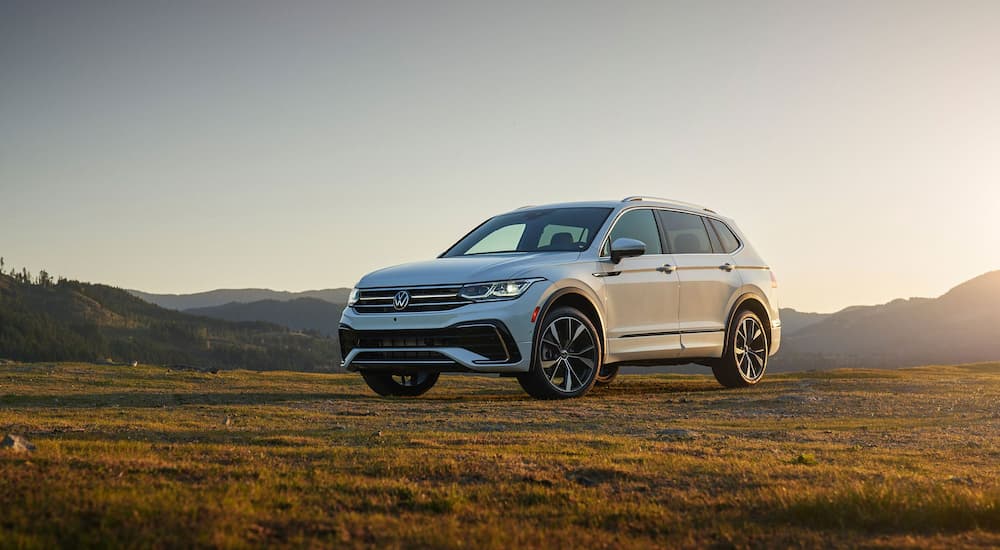Sometimes it’s not the major, obvious overhauls that are the most important as a vehicle slowly evolves over time. For the Volkswagen Tiguan, this rings especially true for its fuel economy ratings. The model has only been on the market for two generations since 2007, and it has had a rocky pathway to finally securing a solid fuel economy rating for the 2022 model year. The achievements for the latest model year could be a deciding factor when SUV shoppers visit a VW Tiguan dealer to consider the latest compact outing from Volkswagen.
What’s interesting, though, is that the Tiguan didn’t always boast the fuel economy ratings it currently has. As mentioned, it was a bit of a rocky road getting to its current rating from the EPA, with a lot of ups and downs along the way. With various iterations and changes, however, the numbers finally evened out—and have put the Tiguan in a very comfortable position as a compact SUV in the highly competitive market segment.
Unimpressive First Start
The early years of the Tiguan didn’t get off to the best start in terms of fuel economy, coming in at an unimpressive 19 MPG in the city and up to 26 MPG on the highway. This essentially put the compact SUV within the same kind of EPA gas mileage range as midsize and full-size SUVs. Worse, the all-wheel drive model and more performance-driven trims brought the estimated MPG down to 18 in the city and 24 on the highway. Trying to sell SUV shoppers a compact SUV that had anything but compact fuel economy likely contributed to the early first-generation sales woes that the Tiguan suffered on the market.
Of course, a lot of considerations have to be made when it comes to new model years. It’s not just fuel economy that companies like Volkswagen have to consider. They also have to make sure that the SUV is competitive within its segment in terms of performance, handling, size, safety, and tech. And, making sure that the Tiguan had a solid base to work from—being based on Volkswagen’s own Touareg platform—the first few years of the Tiguan were its teething years. This model had to find its footing and get rooted before making the necessary improvements in the right areas. Thankfully, Volkswagen did start to listen to customers and improve in the areas that counted.
Era of Fluctuations
Over the course of the first-generation run for the Tiguan, it would fluctuate by model year in terms of fuel economy. For instance, the 2010 Volkswagen Tiguan maintained the same EPA ratings as the 2009 model, but the 2011 Tiguan had a slightly different rating, topping out at 20 MPG in the city and only 25 MPG on the highway. It’s ironic because, for the 2011 model year, the Tiguan improved its MPG rating in the city—up from 19 MPG in the previous year—but down when it came to its highway rating.
In 2012, Volkswagen made some key tweaks to the Tiguan’s automatic transmission, improving the power transfer and reducing the fuel expenditure. This change resulted in the Tiguan maintaining its light handling—while also increasing the overall fuel economy in the city and on the highway. As a result, the 2012 model managed to up its MPG to 22 in the city and 26 on the highway, compared to the previous model year. Unfortunately, 2013 would bring the ratings back down to the 2009 levels, and 2014 would see the Tiguan balance out between the 2009 and 2013 levels—at 21 MPG in the city and 26 MPG on the highway.
The following years, 2015 and 2016, would each follow suit from the 2014 model. Volkswagen would make some minor tweaks and adjustments to the overall packaging. They would add more standard features, rearrange the trims, and tweak most of the comfort and interior accouterments—all while the fuel economy was middling at best. Then, 2017 rolled around, and it seemed like much of the progress VW had been making was then set back.
The 2017 model saw a slight increase in weight, and we also saw a slight decrease in overall fuel economy—down to 20 MPG in the city and 24 MPG on the highway. With higher-end standard features, superior driver assist technology, and modern electronics, the Tiguan also picked up a much higher weight rating. Automotive critics definitely took Volkswagen to task over this issue, and the competitive fuel economy arena was looking grim for the Tiguan.
Fuel Economy on the Rebound
After receiving lots of critical feedback on certain aspects of their compact SUV, Volkswagen refreshed the entire platform for the 2018 model year. An all-new turbocharged powertrain with start/stop technology and combustion improvements saw major differences in how the Tiguan performed. This actually resulted in lower horsepower output—from 200 hp down to 184 hp, but an increase of torque—from 207 lb-ft to 221 lb-ft. The near 7% increase in torque meant more off-the-line power with less work from the engine; plus, the new start/stop tech resulted in overall better fuel economy ratings.
The 2018 Tiguan saw significant fuel economy performance on the new platform, topping out at 22 MPG in the city and up to 27 MPG on the highway—its best numbers yet . VW’s gamble on a more refined engine that focused on efficiency over pure power paid off, especially in the Tiguan’s case, where it long struggled as a compact crossover with mid-to-full-size fuel economy. The tide had turned, though, and now the Tiguan was back in the game and rocking some competitive numbers.
Pushing the Boundaries on Expectations
Instead of settling with nominal fuel economy ratings by the EPA, Volkswagen continued to push forward with the Tiguan. The 2019 model year saw yet another slight boost in its overall fuel economy, upping the overall highway ratings to 29 MPG. Volkswagen edged out every inch of performance from the Tiguan by making slight tweaks and modifications here and there—to improve the overall package. The 2019 and 2020 model years of the Tiguan maintained these fuel economy ratings, while Volkswagen focused on upping the standard equipment, making each trim more attractive to its respective consumer market—and improving overall safety and comfort features.
However, the 2021 model year saw an interesting development. The fuel economy rating slowly crept up a notch. The Tiguan managed 23 MPG in the city—up one from the 2020 model. And then, another spectacular thing happened: The 2022 model year saw a jump in overall fuel economy as well—to 30 MPG on the highway. It was the first time the Tiguan managed those figures; this was a surefire highlight for potential compact SUV shoppers.
Highest Fuel Economy Ratings Yet
So what happened? Why the upgrade, and where did it come from? Well, the general press material doesn’t dive into it, but the devil is in the details. The restyling of both the interior and exterior for the 2022 model year Tiguan came with some interesting benefits: It lost some weight. In 2021, the 2.0-L front-wheel drive Tiguan clocked in at 3,935 lbs; the gross vehicle weight rating for the 2022 model, though, is only 3,765 lbs.
From the 170-lb weight reduction to the restyling and tweaks Volkswagen has made, each played quite a significant role in the Tiguan’s performance efficiency. In real-world testing, outlets like Daily Motor have found that the Tiguan actually performs better than its EPA-estimated ratings—topping out at 34 MPG on the highway. It’s a true testament to how Volkswagen has slowly but surely improved the fuel economy of the Tiguan over the years—from an SUV that was highly criticized to one of the better-performing compact SUVs in its segment.






